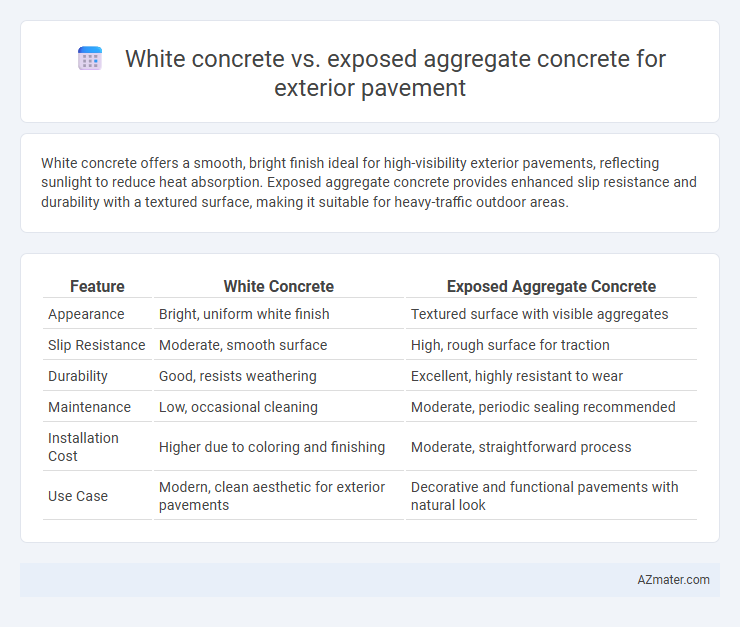White concrete offers a smooth, bright finish ideal for high-visibility exterior pavements, reflecting sunlight to reduce heat absorption. Exposed aggregate concrete provides enhanced slip resistance and durability with a textured surface, making it suitable for heavy-traffic outdoor areas.
Table of Comparison
| Feature | White Concrete | Exposed Aggregate Concrete |
|---|---|---|
| Appearance | Bright, uniform white finish | Textured surface with visible aggregates |
| Slip Resistance | Moderate, smooth surface | High, rough surface for traction |
| Durability | Good, resists weathering | Excellent, highly resistant to wear |
| Maintenance | Low, occasional cleaning | Moderate, periodic sealing recommended |
| Installation Cost | Higher due to coloring and finishing | Moderate, straightforward process |
| Use Case | Modern, clean aesthetic for exterior pavements | Decorative and functional pavements with natural look |
Introduction to White Concrete and Exposed Aggregate Concrete
White concrete features a mixture of white Portland cement and light-colored aggregates, providing a bright, reflective surface ideal for reducing heat absorption in exterior pavements. Exposed aggregate concrete reveals textured, colorful aggregates on the surface, offering enhanced slip resistance and aesthetic variety for outdoor walkways. Both materials contribute to durable, visually appealing pavements but differ significantly in appearance and thermal properties.
Aesthetic Differences: Appearance and Design Versatility
White concrete offers a smooth, uniform surface with a clean, modern look that enhances brightness and complements minimalist designs for exterior pavements. Exposed aggregate concrete features a textured surface with visible stones and pebbles, providing a natural, rustic appearance and greater design versatility through varied color and aggregate choices. The distinct visual textures of white concrete and exposed aggregate concrete cater to different aesthetic preferences, with the former emphasizing sleekness and the latter emphasizing organic, decorative patterns.
Surface Texture and Slip Resistance Comparison
White concrete offers a smooth, uniform surface texture that enhances brightness and reflects sunlight, reducing heat absorption in exterior pavements. Exposed aggregate concrete features a rough, textured surface with embedded stones, providing superior slip resistance ideal for wet or high-traffic areas. The coarse texture of exposed aggregate significantly improves traction compared to the slicker, polished finish of white concrete.
Durability and Weather Resistance Analysis
White concrete offers superior durability and excellent resistance to UV rays, reducing surface degradation and color fading over time, making it ideal for exterior pavement exposed to intense sunlight. Exposed aggregate concrete provides enhanced weather resistance through its textured surface, which improves slip resistance and prevents water pooling, thereby minimizing freeze-thaw damage in colder climates. Both materials demonstrate strong performance in harsh weather conditions, but white concrete excels in thermal reflectivity, reducing heat absorption and extending pavement lifespan under high temperatures.
Installation Process and Construction Timeline
White concrete installation typically involves standard mixing, pouring, and curing steps that align with conventional concrete methods, allowing for relatively straightforward and efficient application on exterior pavements. Exposed aggregate concrete requires an additional surface treatment process where the top layer of cement paste is removed to reveal the embedded aggregates, extending the construction timeline by one to two days compared to white concrete. The added step in exposed aggregate concrete demands careful timing and skilled labor to ensure proper exposure and surface texture, slightly increasing complexity but enhancing aesthetic and slip-resistant qualities.
Maintenance Requirements and Longevity
White concrete offers low maintenance with its smooth surface, requiring occasional cleaning to prevent staining and maintain appearance, and typically exhibits good durability with a lifespan of 30 to 50 years under normal conditions. Exposed aggregate concrete demands more frequent upkeep due to the textured surface that can trap dirt and debris, necessitating regular sealing and cleaning to preserve its aesthetic and protect against weathering, with longevity comparable to white concrete but highly dependent on maintenance consistency. Both materials benefit from proper sealing to enhance resistance to environmental factors and extend service life in exterior pavement applications.
Cost Comparison: Initial and Long-term Expenses
White concrete generally incurs higher initial costs than exposed aggregate concrete due to the specialized materials and finishing processes required. Exposed aggregate concrete offers a more cost-effective solution upfront while providing durable, slip-resistant surfaces suitable for exterior pavements. Over the long term, white concrete may require more maintenance and cleaning to retain its appearance, potentially increasing lifecycle expenses compared to the lower upkeep demands of exposed aggregate finishes.
Environmental Impact and Sustainability
White concrete typically has a lower albedo effect, reflecting more sunlight and reducing heat island effect in urban areas, which contributes positively to environmental sustainability. Exposed aggregate concrete, while aesthetically appealing and durable, often requires more intensive processing and sealing chemicals that may increase its environmental footprint. Choosing white concrete for exterior pavement can enhance energy efficiency by minimizing surface temperatures, whereas exposed aggregate concrete's sustainability depends largely on sourcing and maintenance practices.
Best Applications for Each Concrete Type
White concrete is ideal for exterior pavement applications requiring high reflectivity and heat reduction, such as walking paths, plazas, and urban landscaping where solar reflectance and aesthetic brightness are priorities. Exposed aggregate concrete excels in driveways, parking lots, and pool decks due to its enhanced slip resistance, durability, and decorative textured surface suited for high-traffic or wet environments. Selecting the concrete type depends on balancing functional needs like safety and maintenance with design goals including color retention and surface texture.
Choosing the Right Concrete for Your Exterior Pavement Needs
White concrete offers a clean, modern aesthetic ideal for exterior pavements requiring high reflectivity and heat reduction, enhancing energy efficiency in urban settings. Exposed aggregate concrete provides superior slip resistance and durability, making it suitable for high-traffic areas and locations prone to wet conditions. Selecting between white concrete and exposed aggregate depends on factors like climate, maintenance preferences, and desired surface texture for long-lasting, functional pavement.

Infographic: White concrete vs Exposed aggregate concrete for Exterior pavement
 azmater.com
azmater.com